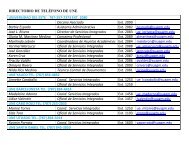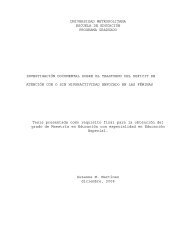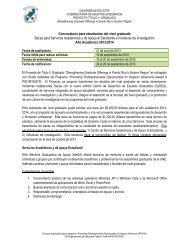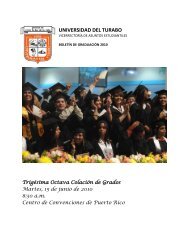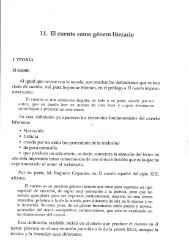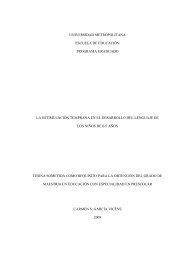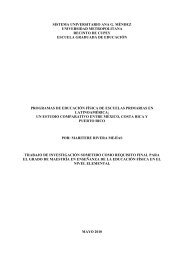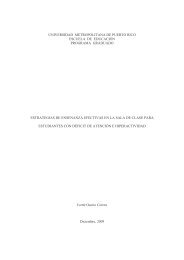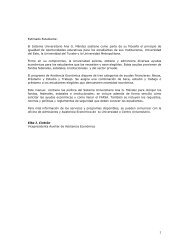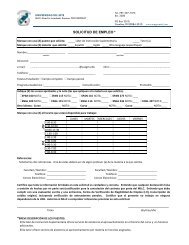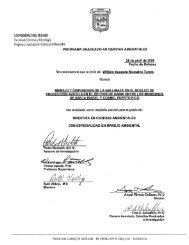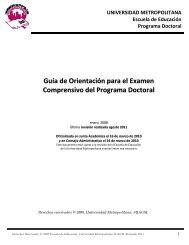Libro de Resúmenes /Proceedings - Sistema Universitario Ana G ...
Libro de Resúmenes /Proceedings - Sistema Universitario Ana G ...
Libro de Resúmenes /Proceedings - Sistema Universitario Ana G ...
Create successful ePaper yourself
Turn your PDF publications into a flip-book with our unique Google optimized e-Paper software.
consist of reaction rates, disassociation constants and binding constants, and ion concentrations.<br />
The mo<strong>de</strong>l consists of a system of ordinary differential equations (ODE)<br />
for different enzymatic states. From the steady-state solution of the ODE system<br />
the net fluxes J M are computed. For different concentration values, the optimization<br />
problem seeks a set of parameters within the parameter ranges that yields values of<br />
J M close, in the Least Squares sense, to the values reported in the literature. The<br />
mo<strong>de</strong>l equations and the optimization problem were solved numerically and different<br />
optimization algorithms were used to solve the optimization problem.<br />
Comparación <strong>de</strong> Rendimiento entre Técnicas <strong>de</strong> Recuperación<br />
<strong>de</strong> la Información<br />
Oliver Pérez Hernán<strong>de</strong>z, Universidad <strong>de</strong> Puerto Rico en Humacao, Departamento<br />
<strong>de</strong> Matemáticas, Humacao, PR 00791-4300,<br />
Consejero: Luis Gabriel Jaimes, Universidad <strong>de</strong> Puerto Rico en Humacao.<br />
En este trabajo se ilustran los resultados obtenidos utilizando tres técnicas clásicas <strong>de</strong><br />
recuperación <strong>de</strong> información en documentos no estructurados: el método booleano, el<br />
vectorial, y el probabilístico. Se muestra una comparación entre el rendimiento y los<br />
resultados <strong>de</strong> los tres algoritmos utilizando como entrada una colección <strong>de</strong> documentos<br />
<strong>de</strong> prueba <strong>de</strong>l proyecto HERMES <strong>de</strong> la Universidad <strong>de</strong> la Américas en México.<br />
Mo<strong>de</strong>los Basados en Agentes <strong>de</strong>l Mecanismo <strong>de</strong> Producción y<br />
Control <strong>de</strong> las Células Sanguíneas en el Cuerpo Humano<br />
José Pimentel, University of Puerto Rico at Humacao, Department of Mathematics,<br />
Humacao, PR 00791-4300,<br />
Advisor: Elio Ramos, University of Puerto Rico at Humacao.<br />
Traditionally, dynamical systems with <strong>de</strong>lay are formulated mathematically using<br />
continuous mo<strong>de</strong>ls based on Delayed Differential Equations (DDE). We are <strong>de</strong>veloping<br />
a mo<strong>de</strong>l of a <strong>de</strong>layed dynamical system, namely the mechanism of blood cells<br />
production and control in the human body, using an agent based simulation. In the<br />
agent based approach we use a reductionism approach where we start with an initial<br />
population of mature blood cells that evolve on time by the combined effect of<br />
production of young cells and <strong>de</strong>cay of mature cells. In this context the maturation<br />
period from young to mature cells is associated with a <strong>de</strong>lay parameter () which introduces<br />
a <strong>de</strong>lay in the dynamics of the system. The mo<strong>de</strong>l will be calibrated with<br />
an standard continuous DDS namely the Mackey-Glass mo<strong>de</strong>l. Also we will use this<br />
mo<strong>de</strong>l to simulate the dynamics of blood cells with blood diseases. With our approach<br />
it’s relatively simple to incorporate more realistic elements in the mo<strong>de</strong>l as<br />
the introduction of a modulation in the <strong>de</strong>lay parameter.<br />
42



